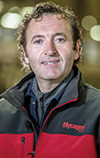I’m either working directly with our silage growers and dairy producers or working with our sales representatives and allied industry personnel. The summer months include generating technology bulletins and conceptualizing hybrid initiatives.
My territory extends from the dairy pockets of Maine west to eastern Ohio and south to Virginia. This time of year, I’m providing field support to southeastern Pennsylvania and the Shenandoah Valley of Virginia, where the growing season is ahead of the other areas.
Through the season, I work my way north. By mid-September, I’ll spend time with dairies in western and central New York. At the end of September into mid-October, I finish traveling in northern New York and New England.
As I travel throughout these areas, it’s fascinating to compare operations that range from Amish farms with 30 cows to commercial dairies milking 6,000 to 7,000 cows. Silage storage methods range from wood silos and bunkers to drive-over piles covering 10 acres.
However, these farmers share the same goals – producing high-quality silage to feed their cows for maximum efficiency. This is where my expertise comes in.
Focus on harvesting
When traveling, I work with silage customers and help them put strategies in place for harvesting quality silage. Harvest management has a large impact on silage quality and dry matter content.
When I joined the company in 2005, dry matter content for our growers in the Northeast region averaged 29 percent. Now, their bunk dry matter average is 33 percent.
We share these types of results by holding “burndown days” to help farmers prepare for silage harvest. Last fall, a fourth-generation farmer milking 1,000 cows hosted one event.
Nearly 70 guests (including company employees and other dairy nutritionists) met on his farm for a day of grilling food, analyzing silage and preparing for upcoming weeks of harvest. We gathered 60 corn silage samples from various fields.
We chopped and dried down the silage to determine the optimum harvest window. We also evaluated bunk management strategies to ensure not only that the crop is stored with the correct dry matter, but also the right equipment is available for good packing density.
This year, we are planning a similar event at the same farm. We will discuss shredlage technology, a new harvesting process for silage. Just like growers, we are learning about this process of chopping at a higher dry matter and cutting it at 26 mm or 30 mm instead of the usual 19 mm.
A sounding board
It’s a philosophy I carry with me when I travel. On a typical day, I may visit six or seven farms. For many of them, I am part of the management team, serving as a sounding board or second set of eyes because of my knowledge and technical support. It is not uncommon for a grower to call and ask: “Hey, my cows have decreased a few pounds in production.
Can you help me figure out why?” As a nutritionist, I interact with farmers on a more intimate level and understand their management support needs. I show my passion by contributing to making these dairies successful.
That passion grew on a dairy and cash-crop operation in central New York that is still run by my family. Growing up, I had a positive farm experience. It was successful and rewarding. I saw the benefits of the operation, and it helped mold my future interests.
While my buddies in town were going on vacation with their families and goofing off while school was out, I was scraping down cow beds, putting in hay, picking rocks and doing whatever else was needed on the farm.
Looking back now, I wouldn’t trade those days. I work with people who share my conviction and motivation to help producers be successful. Besides my five nutritionist counterparts across the U.S., I have the pleasure of collaborating with other dealers, sales representatives and agronomists.
Ultimately, we all serve to benefit the end user – our growers – and to continue evolving our business to become more sustainable for products and innovation.
After all of that effort, the most rewarding part is sitting down with a dairy producer after he has finished feeding a full bunk of brown midrib (BMR) corn silage and has analyzed his results.
Imagine how exciting it is to hear this report from a dairy producer using hybrids, “We’ve saved 30 cents a day per cow because of the higher-quality forages. The cows are peaking 3 or 4 pounds higher than they did the same time last year, and overall, there is increased herd productivity and profitability.”
I find great satisfaction enhancing the profitability of farms. I’m fortunate to work with some of the best-managed farms throughout the country that have become successful through a collaborative effort of education and implementation. FG
John Brouillette
Dairy Nutritionist
Mycogen Seeds










